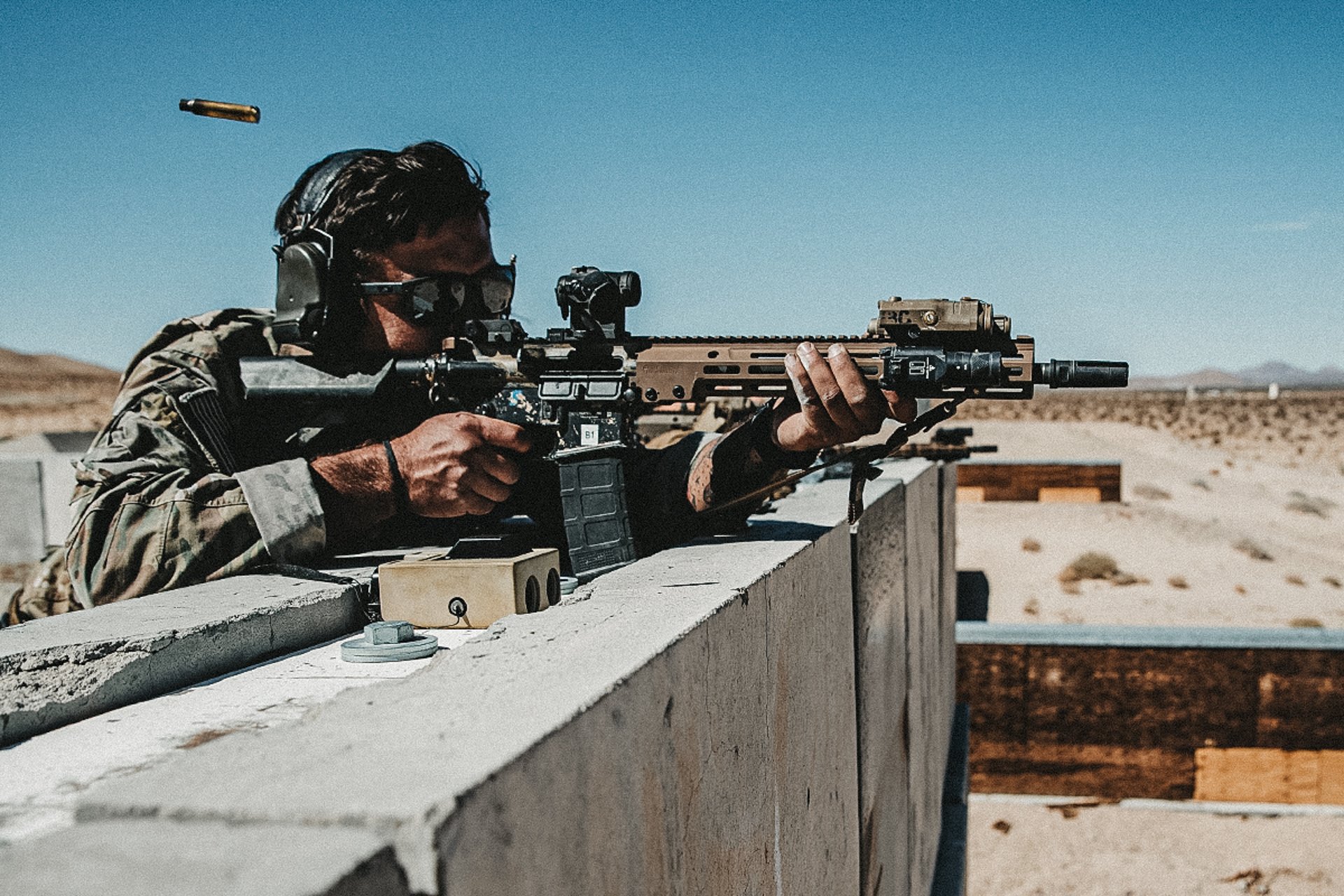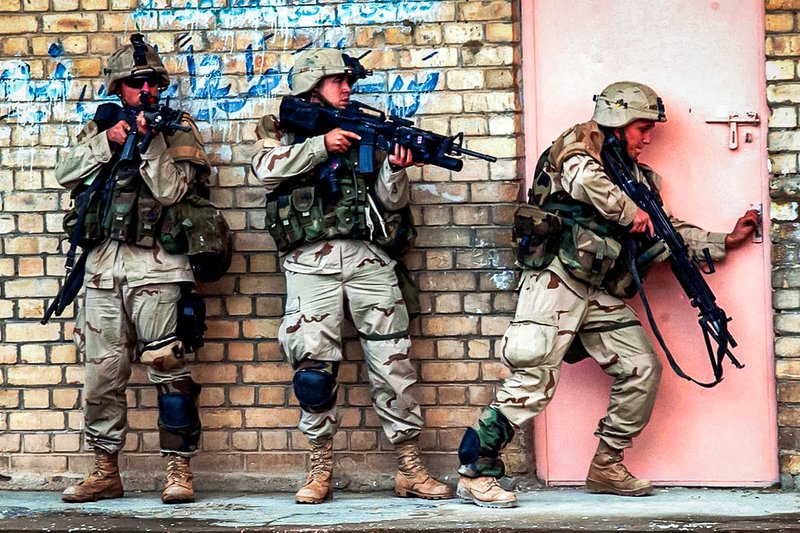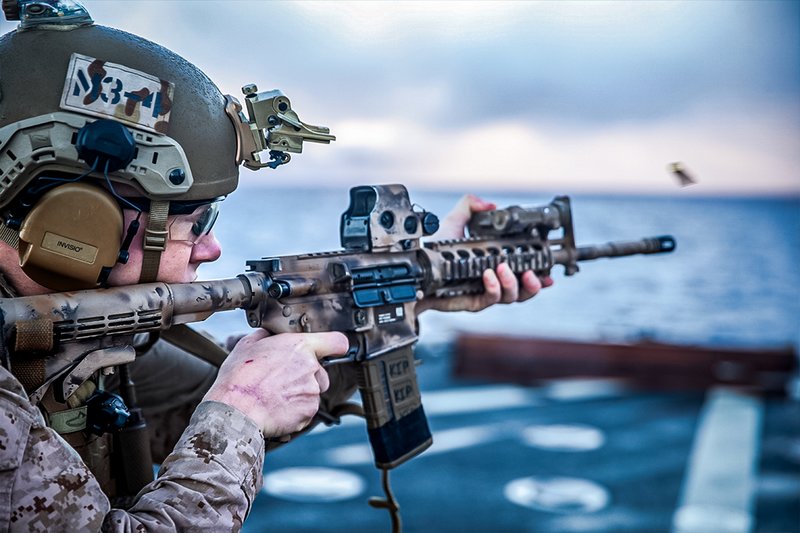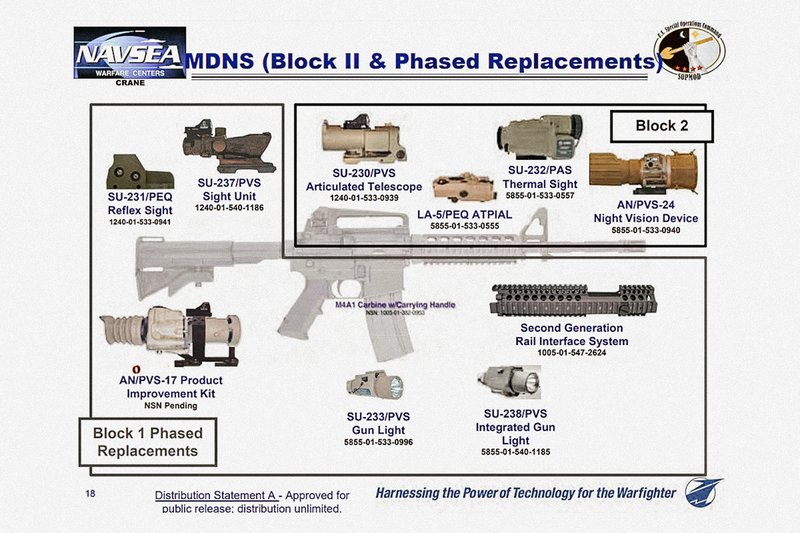
A US Army Special Operation Soldier with 3rd Special Forces Group (Airborne) fires a M4A1 rifle at pop-up targets at Marine Corps Air Ground Combat Center (MCAGCC), Twentynine Palms, California, Oct. 18, 2019. The M4A1 allows service members to stay light, move fast, and engage the enemy accurately. Marine Corps photo by Cpl. William Chockey.
Back in 1994, the US military was still sending people to combat in woodland camouflage and polished black boots. Service members from every branch were lugging around M16s that hadn’t changed much since the 1960s. Then Special Operations Command got what must have felt like a gift from heaven.
It looked like the love child of an M16 and a CAR-15. It came with a box of goodies to customize it however they wanted. The M4A1 had arrived.
Put yourself in their shoes. You kick off a mission in the back of a helicopter; space is cramped so you collapse your weapon’s buttstock to make room. That shortens it up enough to screw a suppressor onto the other end. When you land and hit the objective, you use the stubby barrel, automatic fire, and 30-round magazines to fight your way from dark room to dark room with a laser acting as your sight.

Members of Task Force 2-7 prepare to enter a building in Fallujah on Nov. 9, 2004. Before the M4A1 and M4 carbine, the M16A4 was the primary weapon system of the War on Terror. US Army photo by Sgt. 1st Class Johancharles Van Boers.
Before you can get extracted, the enemy launches a counterassault. You move to the building’s roof, light up the night with a flare from your M203 grenade launcher, switch to a magnified optic, and start picking off targets several hundred yards out with single, precise shots. And all of this takes exactly one weapon: the M4A1.
That’s a damn fine piece of gear, and in time it would be not just a perk for operators, but also the standard fighting weapon of the US Army. It’s time you found out exactly what’s so special about the M4A1, where it came from, and why it has become the darling of Hollywood and video game creators.
Related: Kabar: The Best Knife for a Gunfight

Using a suppressor doesn’t just make the M4A1 quieter, it also reduces the weapon’s muzzle flash and tendency to kick up dust when firing from the prone position. Screenshot from Garand Thumb/YouTube.
M4A1 SPECS
- Caliber: 5.56 NATO
- Capacity: 30+1
- Barrel length: 14.5 inches
- Operation: Direct impingement
- Fire control: Safe, semi-automatic, automatic
- Sights: Rail-mounted iron sights, red dot, fixed-power scope, or low-power variable optic
- Weight: 6.4 pounds (unloaded with no accessories)
- Rate of fire: 700 to 950 rounds per minute
Let’s Field Strip the M4A1
Like the M16 rifle and M4 carbine, the M4A1 adheres to the military’s LMGAS moniker — it’s a lightweight, magazine-fed, gas-operated, air-cooled, shoulder-fired weapon system. It fires a 5.56 NATO cartridge from standard 30-round magazines.
About 80% of its components are compatible with the M16A2 rifle. Anyone who’s fired an M16 or M4 will be right at home with the M4A1, thanks to similar or identical upper receivers, lower receivers, bolt carrier groups, controls, and maintenance procedures.

A US Marine with the All Domain Reconnaissance Detachment, 11th Marine Expeditionary Unit (MEU), fires an M4A1 carbine during a deck shoot aboard amphibious dock landing ship USS Pearl Harbor (LSD 52), Aug. 8, 2021. The M4A1 saw wide use by special operations forces. US Marine Corps photo by Sgt. Jaxson Fryar.
Accessory rails on top of the upper receiver and at the 12 , 3 , 6 , and 9 o’clock positions on the handguard provide mounting options for optics and accessories, like a PEQ-15, red dot, holographic sight, low-power variable optic (LPVO), the Army ACOG, or the Marine Corps RCO. Iron sights are not standard, but there is a fixed front-sight post, and the upper receiver can accommodate a carry handle with a rear sight aperture. The handguard adds mounting options for a vertical grip, bipod, or M203 grenade launcher.
The M4A1 shares the M4’s carbine-length direct impingement gas system, although it’s shorter than the rifle-length system on the M16 and generates significantly more pressure — 17,000 psi instead of 10,000 psi.
The M4A1 features an ambidextrous fire control switch with three settings. Instead of safe, semiautomatic, and three-round bursts, the M4A1 replaces the three-round burst with full-auto. Depending on specific conditions, the rate of fire can range from 700 to 950 rounds per minute. The M4A1 has a thicker barrel to handle the extra heat and stress of automatic fire.
Related: SIG Sauer Will Make the Army’s Next Generation Squad Weapon — Here’s What We Know
The M4A1 Was Born on the Battlefield
The M4A1 is the result of decades spent refining its predecessors: the M16 and M4. The US military adopted the M16A1 in 1963, just in time to send glitchy early production rifles into service in Vietnam. The platform and the ammo it used was revised to improve reliability during the following decades, but the 20-inch barrel, direct-impingement gas system, and lightweight design remained at the M16’s core.
The secret to the M16’s success was the light and fast 5.56 NATO cartridge that allowed US service members to carry twice as much ammunition compared to 7.62 NATO and still reliably engage targets. The M16’s 20-inch barrel extracted maximum performance out of the speedy round, but it made the rifle cumbersome in vehicles and urban environments.
As combat shifted out of open terrain and into cities, decision-makers at the Pentagon started to wonder how much performance they would have to sacrifice to field a more compact, maneuverable service weapon.

The M4A1 has evolved over nearly 30 years to stay relevant. IMFDB photo.
Cue the M4 platform. By chopping the M16’s barrel down from 20 inches to 14.5 inches and giving it a collapsible stock, the US military created a carbine that was easier to maneuver inside a vehicle, more maneuverable in close-quarters combat, and still capable of accurately engaging targets at longer ranges compared with the AK-47.
The first service members to use the M4 were those in special operations and roles that didn’t require a full-sized rifle — think aircrew, tankers, and officers. Most of these carbines were the base M4 limited to three-round bursts. Only SOCOM got access to the fully automatic M4A1, and the first ones hit the front lines starting in 1994. The military originally contracted with Colt to produce M4A1 carbines and began purchasing additional units from FN in 2013.
How the M4A1 Stayed Relevant for 30 Years
The M4 is a solid platform and the M4A1’s upgrades make it formidable on the battlefield, but what really contributed to its longevity was the ability to modify and customize it to fit specific mission requirements. SOCOM — known for continuously transforming to suit the mission at hand — led the way by creating accessory packages that made the M4A1 an elite combat platform. These gear lists are organized into SOPMOD Block I and SOPMOD Block II.

The first round of special operations modifications to the M4A1, known as SOPMOD Block 1, modernized a platform that was similar to the M16 of the 1960s. US Special Operations Command photo.
SOPMOD Block I
The first crack SOCOM took at improving the M4A1 came when the command adopted the platform in 1994. A selection of carefully chosen attachments allowed units to make the M4A1 vastly more capable than it already was. Operators got the following items and could mix and match depending on what they needed from their weapon at any given time:
- Backup iron sights instead of a carry handle
- Rail interface system
- Two reflex sights
- 4-power daytime scope
- AN/PEQ-5 visible laser
- AN/PEQ-2 infrared light
- Visible light
- AN/PVS-17 night vision optic
- Suppressor
- Vertical foregrip
- M203 grenade launcher and leaf sight
- AN/PSQ-18A grenade launcher optic

The M4A1 was further updated with improved optics with SOPMOD Block 2. US Special Operations Command photo.
Phased Replacements and SOPMOD Block II
Over the following years, better options hit the market and worked their way into service. Some items — such as micro red dot backup sights — were phased into use as others — including bulky weapon lights — aged out.
- SU-231 reflex sight
- Micro red dot attachments on the 4-power daytime scope and AN/PVS-17
- SU-233/PVS and SU-238/PVS lights
- Updated rail interface system
Official Block II updates included improved optics and sighting systems in 2005.
- SU-230/PVS articulated telescope
- SU-232/PAS thermal optic
- AN/PVS-24 night vision optic
- LA-5/PEQ infrared laser
Related: Mikhail Kalashnikov: The Man Who Introduced the AK-47 to the Battlefield
An M4A1 for (Almost) Everyone
For much of the Global War on Terror, the M4A1 remained out of reach for everyone but Special Forces. In time, though, its advantages over the lighter-duty M4 and the aging M16 became impossible to ignore.
In 2014, the Army implemented its Product Improvement Program to replace M4s already in service with the more robust and more versatile M4A1 as the standard infantry weapon. Armorers retrofitted the Army’s M4s with a heavier barrel, a fully automatic trigger assembly, and an ambidextrous control switch to get the M4A1 into the hands of more soldiers. Between 2014 and 2018, the Army completed more than 300,000 M4A1 conversions.
At the same time the Army sought to field as many M4A1s as possible, the Marine Corps was still issuing M16s to combat units. It took until 2015 for the Marine Corps to officially replace the M16 with the M4, and Marines couldn’t have been happier.

In 2022, the US Army announced that it will replace the M4A1 with the SIG Sauer XM5. SIG Sauer. Photo courtesy of SIG Sauer.
"The M4 has been slaying bodies at the same distance as the M16 over the past 14 years in Iraq and Afghanistan," Sgt. Brent Susnik, a Marine Corps infantryman, told Marine Corps Times in 2015. "It has proven itself; there just isn't anything the M16 can do better than the M4."
The hassle of lugging around a larger M16 isn’t worth the marginal advantages of a full-length rifle compared to a more nimble carbine chambered for the same round, but the Marine Corps wasn’t willing to make the jump to the fully automatic M4A1.
What’s Next for the M4A1?
Military contracts are big business, and there will always be manufacturers vying for the coveted job of building guns for Uncle Sam. During the M4’s and M4A1’s time in the spotlight, challengers have included the Marine Corps’ controversial Heckler & Koch M27 IAR and the Army’s doomed ACR program. Various platforms have seen varying levels of adoption by the US military, but none could unseat the proven M4 and M4A1 — until now.
Instead of continuing to field the M4A1, the Army is investing in a completely new platform — and cartridge — with the new SIG Sauer XM5 service rifle. This new platform also includes the XM250 machine gun, which will replace the M249 SAW. Both are chambered for SIG 277 Fury. Making a change of this scale takes time, so you can expect to see the M4A1 stick around for at least a few more years, especially in support, administrative, and reserve units.

The M4A1 made an appearance during the climactic scene of HBO’s The Last of Us, Season One. Screenshot from HBO/IMFDB.
The M4A1 Is a Pop Culture Icon
The US military may be ready to move on from the M4A1 after nearly three decades, but the general public is not. The platform still has a cult following among firearm enthusiasts and makes appearances in movies, television, and video games.
The first film to put an M4A1 on the big screen was Air Force One in 1997 — in the hands of a villain, no less. It also earned screen time in Tears of the Sun, Sicario, Captain America: Civil War, Triple Frontier, and Extraction. It made a splash recently in HBO’s The Last of Us when protagonist Joel used a captured M4A1 to even the odds while clearing a building (which was the correct choice, by the way).
Notable video game appearances of the M4A1 include Urban Terror, Counter-Strike: Global Offensive, Resident Evil 3: Nemesis, Medal of Honor, Call of Duty: Modern Warfare 3, and Ghost Recon Breakpoint.
Can I Own an M4A1?
With ATF approval, almost anything is possible. Most people will have to settle for an M4A1 clone, though. That means you can get a collapsible buttstock and a heavy barrel but with semiautomatic fire and a 16-inch barrel. In other words, you can have a nice AR.
Read Next: Man's Best Friend: Firefighter and Warfighter Robot Dogs

Scott Murdock is a writer, photographer, and Marine Corps veteran. As a gear reviewer in the outdoor and automotive spaces, he has covered everything from pocket knives to off-road vehicles for publications including Task & Purpose, Outdoor Life, and HotCars. He lives in southern Wisconsin, where you can find him making Black Rifle Coffee cold brew and obsessively sharpening his axes.
BRCC and Bad Moon Print Press team up for an exclusive, limited-edition T-shirt design!
BRCC partners with Team Room Design for an exclusive T-shirt release!
Thirty Seconds Out has partnered with BRCC for an exclusive shirt design invoking the God of Winter.
Lucas O'Hara of Grizzly Forge has teamed up with BRCC for a badass, exclusive Shirt Club T-shirt design featuring his most popular knife and tiomahawk.
Coffee or Die sits down with one of the graphic designers behind Black Rifle Coffee's signature look and vibe.
Biden will award the Medal of Honor to a Vietnam War Army helicopter pilot who risked his life to save a reconnaissance team from almost certain death.
Ever wonder how much Jack Mandaville would f*ck sh*t up if he went back in time? The American Revolution didn't even see him coming.
A nearly 200-year-old West Point time capsule that at first appeared to yield little more than dust contains hidden treasure, the US Military Academy said.












